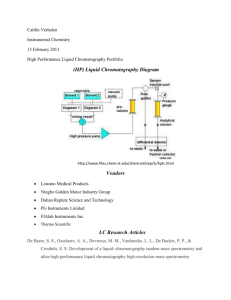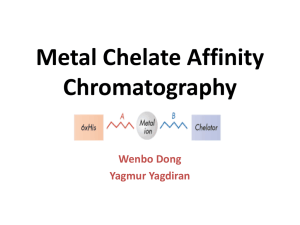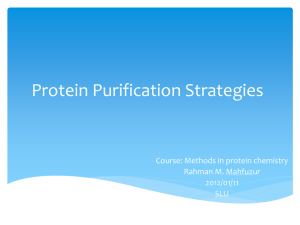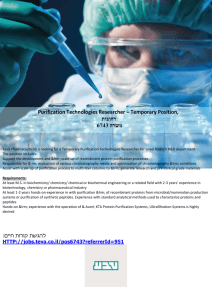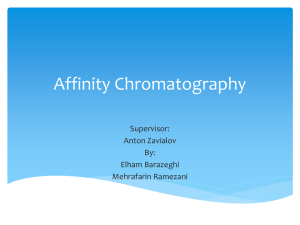URM Prospectus
advertisement
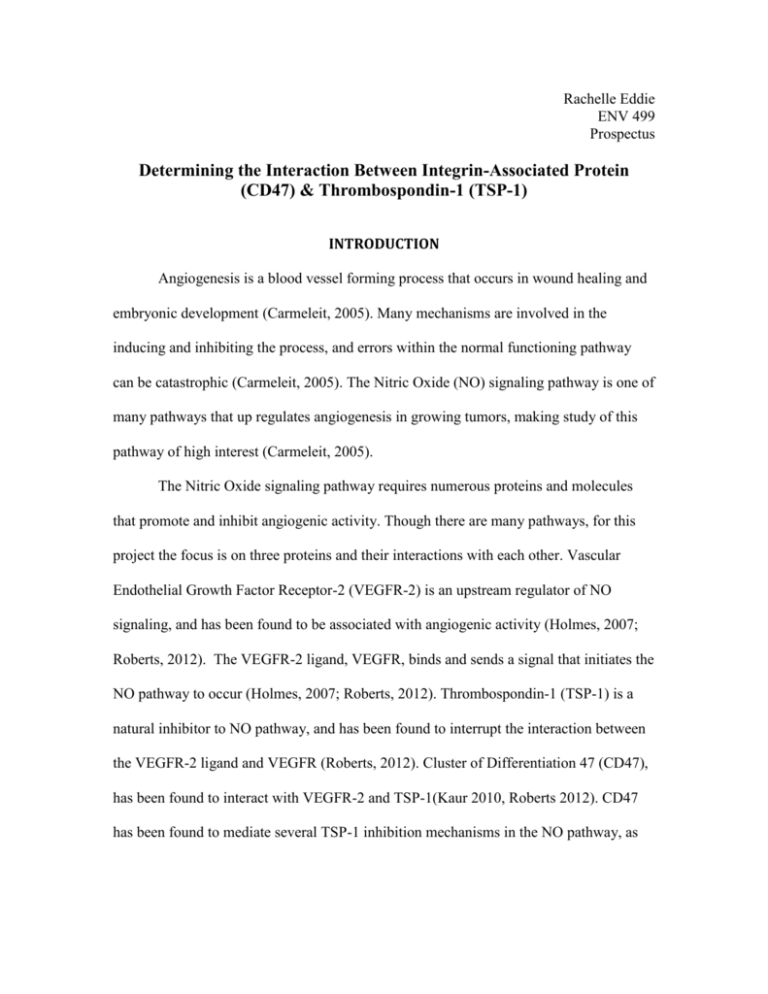
Rachelle Eddie ENV 499 Prospectus Determining the Interaction Between Integrin-Associated Protein (CD47) & Thrombospondin-1 (TSP-1) INTRODUCTION Angiogenesis is a blood vessel forming process that occurs in wound healing and embryonic development (Carmeleit, 2005). Many mechanisms are involved in the inducing and inhibiting the process, and errors within the normal functioning pathway can be catastrophic (Carmeleit, 2005). The Nitric Oxide (NO) signaling pathway is one of many pathways that up regulates angiogenesis in growing tumors, making study of this pathway of high interest (Carmeleit, 2005). The Nitric Oxide signaling pathway requires numerous proteins and molecules that promote and inhibit angiogenic activity. Though there are many pathways, for this project the focus is on three proteins and their interactions with each other. Vascular Endothelial Growth Factor Receptor-2 (VEGFR-2) is an upstream regulator of NO signaling, and has been found to be associated with angiogenic activity (Holmes, 2007; Roberts, 2012). The VEGFR-2 ligand, VEGFR, binds and sends a signal that initiates the NO pathway to occur (Holmes, 2007; Roberts, 2012). Thrombospondin-1 (TSP-1) is a natural inhibitor to NO pathway, and has been found to interrupt the interaction between the VEGFR-2 ligand and VEGFR (Roberts, 2012). Cluster of Differentiation 47 (CD47), has been found to interact with VEGFR-2 and TSP-1(Kaur 2010, Roberts 2012). CD47 has been found to mediate several TSP-1 inhibition mechanisms in the NO pathway, as well as associating with VEGFR2 in NO synthesis (Roberts, 2012). Currently, the interaction between CD47 and TSP-1 is the primary focus. The project will proceed in a series of steps. Initially, we have to produce working soluble protein to test with through recombinant protein expression and purification. Experimentation can begin once we have pure protein, and our first step would be to determine whether we can measure an interaction between CD47 and TSP-1. Next, we can determine if we can affect this signal through mutation to the domains. The interaction will be studied and measured using Native Gels, size exclusion chromatography, and fluorescent anisotropy. These results will clarify which regions of the proteins are interacting and will guide future protein-protein interaction studies with the components of the NO system. The relevance and importance can contribute to the greater understanding of the NO system and how it plays a part in the physiology of angiogenesis. In the case of cancer, more knowledge will provide advancement in medical knowledge for finding a possible cure. METHODS The first step in this project is to develop a protocol for each protein of interest. We must have conditions for expression and purification to avoid any unnecessary contamination and inconsistencies in producing pure protein. Once we produce protein we can move on to experimentation. In the first step of experimentation, we would determine if an interaction exists between CD47 and TSP-1. Secondly, mutations will be made to the CD47/TSP1 domains to disrupt the CD47/TSP1 interaction in pinpointing the location of the interaction. Recombinant Protein Expression/ Purification Recombinant Eukaryotic protein expression is a method used to produce protein in in-vitro conditions. The goal of this is to produce soluble protein for future experimentation use. This process begins by introducing the desired DNA to the cell with the intent to grow and produce large amounts of protein from the cells. The cells will undergo a process of lysing and filtering to remove the protein from the cells followed by purification through affinity chromatography. The proteins we are working with are all tagged with another protein that is easy to identify. Thus, affinity chromatography works due to the charge of the tags and their interaction with the column that is in use. This allows us to separate the protein of interest from residual proteins left over from the E-Coli cell line. Further, we will verify whether we obtained soluble protein and determine how clean it is using methods of Western Blotting, and SDS silver staining. These proteins are identified based on their molecular weight and where they measure up to based on the ladder. Interaction and binding studies Interaction and binding studies will be carried out using different techniques to identify the region where the amino acids are actually binding. These techniques include Native gel, size exclusion chromatography, and fluorescent anisotropy. Native gel is a similar technique to SDS gel electrophoresis, but the difference is SDS is not used, thus the protein will not be denatured. Native gels are used more in measuring interactions between proteins. If there is interaction occurring there will be a difference in one band, compared to the controls that show different bands when they are alone. Size exclusion chromatography separates proteins based on their size. Fluorescent anisotropy measures the effect light has on spinning molecules. PRELIMINARY DATA 1 18°C 25°C 2 3 4 5 6 7 8 9 10 11 12 13 14 15 kDa 60 50 40 Ni+2 1 kDa 60 50 20 2 3 4 GST 5 6 7 8 Figure 1: Silver Stain of CD47-GST construct suggests purification. The expressions were purified in a Ni+2 affinity column. Lanes 2& 11(18 °C & 25 °C respectively) have bands in the 50 kD region that are consistent with CD47 and its tag which is about 53 kD. Figure 2: Silver Stain of CD47-GST construct suggests purification. The expressions were purified in a GST and Ni+2 affinity columns. In lanes 3-5, bands appear, but they are inconsistent with the weight of the CD47 construct. In lane 6, a band appears at about 50 kD which is consistent with the weight of the 53 kD CD47. The results presented in figures 1 & 2 are examples of expression and purification conditions. The conditions used to express the CD47 construct varied in figure one. One expression contained cells that were grown overnight after the induction phase at 25° C, 90 rpm and another at 18° C, 90rpm. These cells were lysed and purified using Ni+2 chromatography. The gel shows two distinct bands in lanes 2 & 11, that appear in the 50 kDa range, which is consistent with the weight of the CD47 construct of about 53 kDa. Figure 2, contains protein that were expressed at the same conditions (25°C & 90 rpm), but purified from two types of chromatography (Ni+2 affinity chromatography and GST affinity chromatography. The expression purified from the Ni+2 affinity column show a greater amount of residual bands in comparison to the expression purified from the GST affinity column. Lanes 3-5 has bands that appear, but none that are consistent with the weight of the CD47 construct. Lane 6 has a band that appears to be consistent with the weight of the CD47 construct. ANTICIPATED RESULTS In determining the CD47 construct, western blotting will be used to determine that the correct protein has been expressed and purified. The protocols in expression and purification must produce the most soluble protein consistently to move on to experimentation. Studies focused on binding will be conducted using methods such as size-exclusion chromatography, native gels, and fluorescent anisotropy are techniques we can use to test such experiments. Once we establish an interaction, mutations will be applied to the constructs to see if and where we disrupt an interaction. The implications of this project will help give a greater understanding and appreciation of the angiogenic pathway that occurs. It will provide valuable information in addressing cancer and cardiovascular diseases. SOURCES Carmeliet, P. (2005). Angiogenesis in life, disease, and medicine. Nature Publishing Group, 438, 932-936. doi:10. 1038/nature04478 Brown, E.J., & Frazier, W.A. (2001). Integrin-associated protein (CD47) and its ligands. TRENDS in Cell Biology, 11, 130-135, Retrieved from http://biochem.wustl.edu/frazier/pubs/tcb11130.pdf Holmes, K., Roberts, O.L., Thomas, A.M., Cross, M.J. (2007). Vascular endothelial growth factor receptor-2: Structure, function, intracellular signaling and t therapeutic inhibition. Cellular Signalling, 19, 2002-12, Retrieved from http://www.ncbi.nlm.nih.gov/pubmed/17658244 Kaur, S., Martin-Manso, G., Pendrak, M.L., Garfield, S.H., Isenberg, J.S., Roberts, D.(2010) Thrombospondin-1 Inhibits Vascular Endothelial Growth Factor Receptor-2Signaling by Disrupting Its Association With CD47. The Journal of Biological Chemistry, 285, 38923-38932, Retrieved from http://www.jbc.org/content/285/50/38923.full Roberts, D. D., Miller, T.W., Rogers, N.M., Yao, M., Isenberg, J.S. (2012). The matricellular protein thrombospondin-1 globally regulates cardiovascular function and responses to stress via CD47. Matrix Biology, 31, 162-169, Retrieved from http://www.ncbi.nlm.nih.gov/pubmed/22266027


